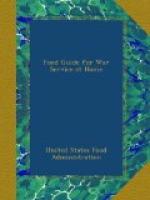THE 50-50 RULE. ANOTHER WAY TO CUT THE CONSUMPTION OF WHEAT
Not only must the miller manufacture flour in accordance with new regulations, but the individual consumer must buy it under restrictions. To many people the first realization that war and food difficulties are necessarily associated, came with the announcement in the spring of 1918 of the now familiar rules for the purchase of flour. With every pound of white wheat flour, the purchaser must buy a pound of some other cereal; with every pound of Graham flour, three-fifths of a pound of other cereal.
The purpose of this regulation is, of course, to lessen the use of wheat by increasing the use of the substitutes. The housekeeper who through lack of initiative or ingenuity fails to feed the family the substitutes and lets them accumulate on her shelf has just so far failed to co-operate with the Food Administration. Many a housewife has learned the value of these cereals and will continue to use them long after the war and the Food Administration have passed into history.
A little thought will show the absence of any real burden in the 50-50 rule. A housekeeper for her family of four buys five pounds of wheat flour and five pounds of other cereals. She may use 11/4 pounds of the substitutes with the 5 pounds of wheat flour to make about 8 pounds of Victory bread—sufficient to give each member of her family 2 pounds of bread during the week. She may serve an ounce of oatmeal as the breakfast cereal and an ounce of rice, hominy, or other cereal for each person daily and will then have used all the substitutes. These cereals can be made into an endless variety of quick breads, cakes, and pastry, or combined with other foods as the main dish of the meal.
SUBSTITUTES FOR WHEAT FLOUR
The cereals on the market are varied enough to suit any taste. Remember that as far as nutritional value is concerned, it makes practically no difference whether we eat wheat or oats, rye or barley. The quantities of starch, protein, mineral matter, and fat are so nearly the same that any one of them can take the place of another. Oatmeal has a slight advantage over wheat both in protein and fat, and since oats is an abundant crop in our country it is an excellent substitute. Rice has a very little more starch and less protein than the others.
There is just one advantage that wheat flour has over the other cereals—it can be made into lighter and more durable bread. The reason for this is given in the next chapter.




